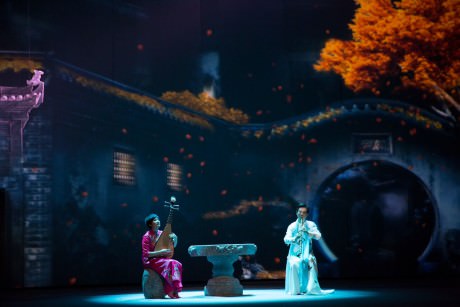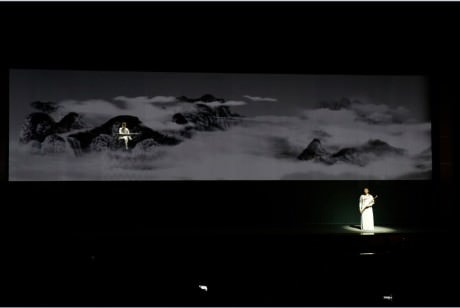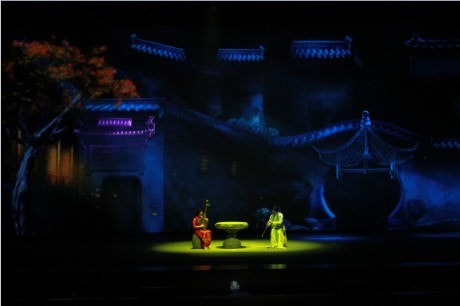Having just returned from China—where one of the highlights of the trip was hearing traditional music performed casually in teahouses and parks—I was curious to see how these simple melodies would emerge in Rediscover Chinese Music, a mammoth multi-media spectacle on stage this weekend at The Kennedy Center’s Opera House.
Would these folk songs live up to the hype of all the promotion aired daily on radio and TV?

Moreover, would poems—some of them written 3,000 years ago—have any resonance in today’s turbulent world?
The answer, to my relief, is an unequivocal “Yes,” thanks to the formidable array of talent lined up for this US premiere of a concert created for the China National Traditional Orchestra.
Consisting of ten traditional songs, Rediscover Chinese Music offers breathtaking performances by an army of musicians and a chorus. A narrator serves as storyteller, his words translated into English on a screen above the stage. Many of the instruments are replicas of those detailed in the murals found in the caves of Dunhuang.
In China, “traditional” does not always mean old. Although most of the songs are based on ancient poems and tunes, a few are new arrangements of relatively modern compositions.
One of the most moving pieces, for example, is an homage to a composer named Abing, who recorded a popular song in 1950. Through the narrator, the performer expresses his awe at being able to play a song written by his idol.

Through a series of sensational backdrops—consisting of video projections on scrim over scrim—The Kennedy Center stage is transformed into a world of palaces and pagodas, mountains, and deserts, leading the audience on a journey through time.
Transported to a mountaintop in an ancient world, a musician and a woodcutter demonstrate their loyalty to each other. The music ends when the woodcutter dies.
In another setting—the courtyard of a palace—the blossoms of a plum tree fall on an elegant man and woman playing the flute and a string instrument, similar to a lute. The leaves turn color and snow falls, yet the flowers survive.
Nature—in the form of mountains and skies—plays an important role in Chinese culture. In Rediscover, one of the wittiest tributes to the natural world comes in Song of the Birds. Dozens of musicians, playing Chinese wind instruments similar to clarinets and flutes, call to each other from the balconies and the orchestra, filling the opulent hall with a cacophony of forest sound.
A raging battle conducted 2,200 years ago is immortalized in Ambush from Ten Sides, as a pagoda, in which two women are seated, splits in two. Land and sky are transformed into music as drums and cymbals clash. Yet the pagoda, at the end, is restored.
Modern warfare is the finale to the program. Yellow River, adapted from the Cantata of the same name, is an all-out tribute to China’s role in World War II. The new rendition combines the entire 110-piece orchestra with dozens of singers and soloists, all performing against a backdrop of brilliant multimedia projections.
Included in this production are 40 children from the Washington Yu Ying Public Charter School Chorus. The children, ages 8 through 10 and mainly Caucasian and African-American, are all winners of an audition conducted by the school.

Much of the credit for Rediscover Chinese Music goes to its director, Wang Chaoge, who also wrote the script for the production and is considered the founder of large-scale live multimedia production in China. No stranger to US audiences, Wang made her debut at the Metropolitan Opera nearly 10 years ago when she directed The First Emperor, starring Placido Domingo. Her appearance on stage provoked a long standing ovation on opening night.
Resident Conductors Liu Sha and He Jianguo both do an excellent job presiding over the pit, the stage and the audience. He Jianguo also serves as the somewhat jocular narrator.
The very affable concert master is Tang Feng. Jiang Ying is the composer and arranger who created or adapted all the music, recasting it, in some cases, for western audiences.
Li Bin’s stage design and Wang Yugang’s lighting design bring incredible drama to sets that might otherwise have seemed static. Gan Hua and Zheng Zejian, who worked with Wang Chaoge on multimedia design, work magic with projections. They create doors and windows, wind and snow–and even flying geese–out of screens.
The costumes, by Zuo Huanyu, are exquisite, alternating between silk pajama-like robes for some performers and sheer embroidered jackets for others. Shen Tian is responsible for sound design, and Xi Qiang is the producer.
If there is any flaw in this production, it is the overly self-promotional tone of the script. However, this is a national orchestra, administered by the Ministry of Culture and brought to the United States as part of Image China. This is propaganda, done extremely well. And who knows–maybe our own cultural exchange programs do the same.
China-watchers, take note. Music-lovers, stagecraft fanatics and historians aren’t the only ones who will enjoy, and learn something from this production.
Running Time: Two hours, with one intermission.
China National Traditional Orchestra’s Rediscover Chinese Music plays through tomorrow, December 13, 2015, in The Kennedy Center’s Opera House – 2700 F Street, NW, in Washington, DC. For tickets, call the box office at (202) 467-4600 or (800) 444-1324, or purchase them online.
RATING:




